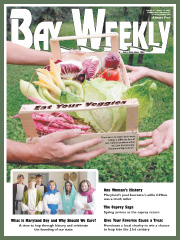Chesapeake Bay's Independent Newspaper ~ Since 1993
1629 Forest Drive, Annapolis, MD 21403 ~ 410-626-9888
Volume xviii, Issue 11 ~ March 18 - March 24, 2010
Home \\ Correspondence \\ from the Editor \\ Submit a Letter \\ Classifieds \\ Contact Us
Best of the Bay \\ Dining Guide \\ Home & Garden Guide \\ Archives \\ Distribution \\ Advertising![]()


The Year of the Oyster
You’ve got a few more days to eat ’em and to help decide how to save ’em
The mood’s too somber in this year’s General Assembly to give Maryland another state creature (song, sport or dessert, either). But if that pastime of richer years were practiced, the Chesapeake oyster would rise to the occasion. Because this is the year Crassostrea virginica will be saved in the Bay — or lost.
“It’s the perfect storm for the oyster,” says one of the players fighting behind the scenes to make 2010 the year Maryland turned the tide to saving, rather than losing oysters.
How we got here is a long and interesting story.
Here’s a short version, built on the analogue of how an oyster makes a pearl. Years of bad oyster news were the grain of sand. Discomfort led to actions to isolate the irritant. In the process, scientists learned a lot about oysters and the diseases and environmental conditions afflicting them. Knowledge accumulated, and a host of actions were taken to rid oysters and the industry of the irritant. Nothing worked. The pearl kept growing.
In near despair, oyster planners were near giving up. We’d import an oyster, and start from scratch. Oystermen would have work, and the alien colonies would filter Bay and tributary waters.
If it weren’t for the havoc other alien imports had wrought (think kudzu), Ariakensis might be growing in our waters now. That threat got the wheels turning, slowly. It took from 2003 to 2009 before we decided to put all our oysters in Virginica’s basket. The pearl was beginning to shine.
Last December, Maryland finally got its Oyster Restoration and Aquaculture Development Plan. It was introduced at four daylong meetings across the state in January. It’s been a long time — perhaps since the rockfish moratorium of the 1980s — since so many people have joined in making decisions about the fate of a species.
The plan proposes 10 steps toward achieving two grand visions. To reach those visions, fewer wild oysters will be available for harvest. More of Maryland’s good oyster bottom — perhaps one-fourth — will be set aside as sanctuaries. Oystering will trend toward aquaculture rather than wild harvesting.
Understandably, watermen fear the plan means the end of their livelihood. Conservationists, meanwhile, fear watermen will dilute the plan until it’s too weak to save oysters.
By mid-April, the details must all be worked out. The good news, insiders say, is that people are listening to one another and even moving toward consensus — over the urgency of the issue and the need to act now.
Find and comment on the very readable plan at http://dnr.maryland.gov/fisheries/oysters/pdfs/OysterOpenHouseFINAL2a.pdf.
© COPYRIGHT 2010 by New Bay Enterprises, Inc. All rights reserved.
